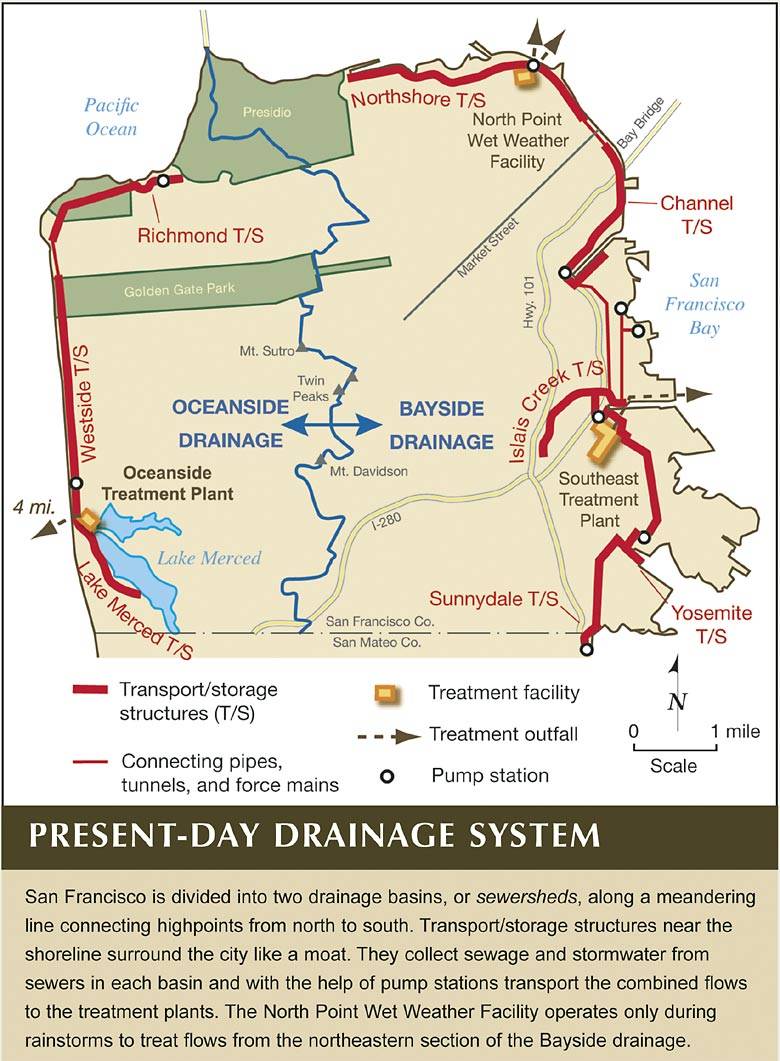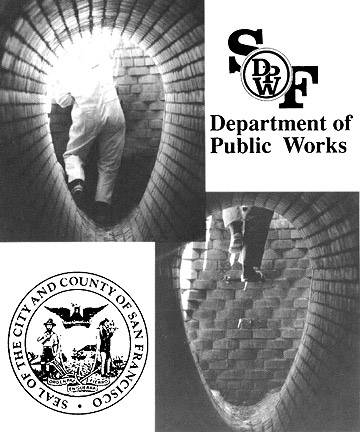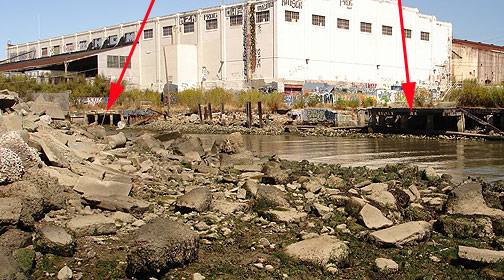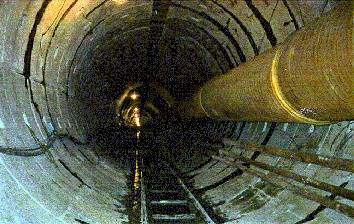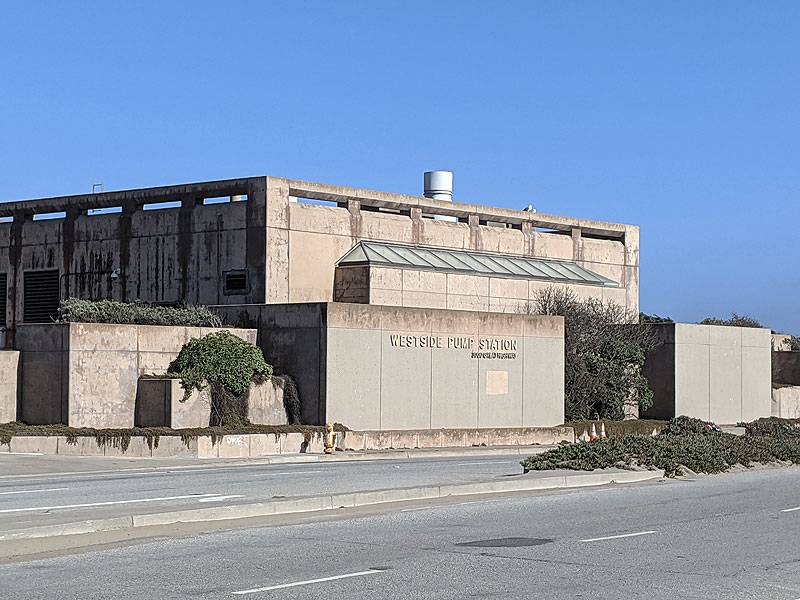Sewerage
Historical Essay
by Steven Bodzin, originally published as a leaflet accompanying the "Sewer Tour" sponsored by the SF Bike Coalition, Dec. 1995
San Francisco's Combined Sewer Overflow Control Facilities, 1993
Image: San Francisco Public Utilities Commission
| Since the gold rush era, the unique climate and geography of San Francisco has posed challenges for generations of civil engineers attempting to modernize its sewer systems. The huge differences between precipitation volume during the wet and dry seasons, combined with the difficulty of routing sewers up and down the hills have caused the need for three distinct systems throughout San Francisco history. These sewer projects were some of the most expensive public works in city history, and these projects’ different priorities give insight into the changing balance of power in the city over time. |
In the beginning, San Francisco was a grassy country of hills and valleys, rills and wales. Small lakes dotted the landscape, and springs bubbled forth. In the spring rains, water hit the steep slopes and tumbled down, swelling boulder-filled creeks, spreading out on the eastern flats and dissolving into the dunes of the west. Much of the runoff was carried in arroyos, seasonal creeks that in summer and fall become almost dry, rocky flats, surrounded by reeds and grasses.
<iframe src="https://archive.org/embed/RoseyJencksOnSewerage" width="640" height="480" frameborder="0" webkitallowfullscreen="true" mozallowfullscreen="true" allowfullscreen></iframe>
Rosey Jencks gives an overview of the history of San Francisco's sewers in this March 7, 2018 presentation at the Shaping San Francisco Public Talks series.
Video: Shaping San Francisco
Precita Creek was one such arroyo. It fell from "Sun Valley" (south of Noe Valley), was joined by springwater and runoff from Bernal Heights, and at high water cut a 30-foot wide path across the southern Mission District, along today's Cesar Chavez Street. Its waters dispersed on the way to Potrero Hill, and eventually ended up in Islais Creek's vast estuarine bog.
By the 1860s, the area near today's Precita Park had become a small village. Some 30 houses lined the creek, drawing their water upstream and using the creek as an open sewer. The marginal water flow in the stream was inadequate to properly carry the sewage off, and as a sanitary measure, the city built the first box sewer. This sewer was thirteen feet across and ten feet tall, a wooden hallway big enough to drive a carriage through. The sewer was made large enough to carry storm flows--the volume of water that comprised a 30-foot wide creek. During dry season, the box was nearly empty, except for a trickle of liquid at the bottom. A couple years after its construction, an internal inspection found the box to be a stinking mess. Solid wastes had built up where laterals, or residential hookups, connected to the big box. Strange foliage grew in the darkness, fertilized by the human waste and compost that congealed on the floor. Indeed, the ecosystem inside the box was so efficient at removing nutrients, the water flowing out at the east end of the sewer near today's General Hospital was clean enough to drink.
Sewer Design
At the same time that Precita Creek was being turned into the Army Street sewer, London was building the world's biggest municipal waste-carrying system. It was capable of handling flows of 100 million gallons per day (mgd), which is comparable to what modern day San Francisco discharges in dry weather. Engineers in London determined the ideal slopes, sizes, and shapes for sewers, encouraging a clear design of smaller pipes flowing to larger, and a gradual slope and steady flow throughout the system.
The climate and topography in San Francisco precluded such careful design, and politics made the situation worse. Some pipes had to be on steep slopes, and it seemed impossible to build pipes that would be equally utilized in dry July and soaking February. Though some people knew that pipes should flow from smaller to larger, collect, and dump at a chosen location, the unplanned construction typical of a Gold Rush city made disasters like Precita Creek the order of the day. Alternatives were suggested at the time. Leaving the creeks at the surface would have meant that the sewers could be smaller, more efficient, and more effective. One leaflet suggested a great number of reservoirs, draining into the sewers to keep the wastes moving, with the effluent, or sewage waste, used as fertilizer and irrigation for Peninsula farms.
There were plenty of problems with the old sewers. They were built haphazardly in random sizes, crossing one another wherever they met, flowing into the nearest open water. Storm drains were combined with household flow, in what came to be called "combined flows." Cesar Chavez Street's box was a comparative success. Mission Creek had thirteen sewers dumping into it, making the area stink beyond belief. One of these sewers came over three miles from the end of Fell Street, by what is now Golden Gate Park. It filled with sand on every possible occasion. It could be cleaned one day and have six inches of sand in it the next. Worse still, the sewers at Mission Creek, as at the twenty-two other outfalls, or sewer openings, were in tidal water. When tides were high, the ends of the sewers were sealed off. When water rose back into the pipes, it forced gases from inside the sewer to exhaust back into the residences of the city, filling them all with stench. Many people suspected the sewers of facilitating the spread of disease.
As the city expanded out of old Buena Vista Cove, it expanded into the bay. When the great seawall was constructed, only a block or two back from today's Embarcadero, nobody bothered to poke holes for some of the sewer outfalls. Some stony streets developed sewage-filled sinkholes when the sewers dumped their loads inside the seawall, undermining the newly extended streets. In the same neighborhoods, by 1892, vegetable gardens were under sewage irrigation.
Updating the Sewers
In 1893, the city hired engineers to develop a master plan for a new sewer system. As the city is wont to do, it took the plan and shelved it. In 1899, it had another plan put together. It, too, was shelved. Seven more years passed, and the city fell down into a shuddering heap of ashes. While the godawful sewer system survived the earthquake of 1906, all the sewer engineering records were lost. The only record we have of the old sewers is a set of notebooks from public works engineers who tried to survey the pipes after the quake, along with the summary reports of the various master planners.
From 1908 to 1935, sewers were gradually organized into zones, with each area dumping to the bay or ocean in one of the 35 outfalls. Citizen groups demanded usable beaches, and particularly faulted cities like San Francisco that had mismanaged their coast. Under this pressure, and with federal public works money flowing easily under the New Deal, the second wastewater master plan was released in 1935. It called for treatment plants to capture sewage and treat it to what is called a primary level-removal of gross debris and grit. In 1938, the first treatment plant, at the end of Golden Gate Park, went into operation. In 1951, two more plants were built. One plant, at North Point, filtered effluent and pumped it into the bay near Pier 39, while sending the leftover sludge south for further treatment. A bigger plant at Phelps and Jerrold processed the waste from the southeast corner, including most of the city's industrial waste. It dried sludge into soil, including that from North Point, notably insulated from wealthy white noses. Each of the three plants took care of one area of the city, along natural drainages.
Dry sludge, or cake, from Jerrold Street was used for years as a fertilizer. Families could go to Golden Gate Park on the weekend and pick up a load of cake for the garden. Alas, in the 1960's, it was found that this cake is high in various heavy metals, like mercury, selenium, lead, and nickel. Now the soil is only used to fertilize fields growing animal feed, or as landfill.
In dry weather, all of these plants dumped primary-treated effluent directly into the bay or ocean. However, in wet weather, they, along with all the old outfalls at Mission Creek, Mile Rock, Marina Green, Fort Funston, Griffith Street, and elsewhere spewed unprocessed sewage. Big pools of discolored, toxic water were often visible, and many residents were bothered by the continued lack of swimming and fishing opportunities along the waterfront. Even in the 1960s, with growing environmental awareness all around, people pointed out that there were often over 100 days per year when Ocean Beach was too poisoned for swimming.
The Clean Water Program
Citizen annoyance combined with federal regulations to force the city to modernize its sewers even more. In 1971, the city came up with its third and most recent master plan for the sewers. It called for a series of massive boxes to be built around the city's waterfront, intercepting old outfalls like a moat. The boxes would be big enough to hold the water of normal rains, delivering it slowly enough to the treatment plants that they could treat it properly before releasing it. The captured water would be sent to modernized treatment facilities at Jerrold Street and at a new, super-modern Southwest plant by the zoo. Overflows in the east would not be dumped into the bay, but rather sent by a tremendous tunnel to the Southwest plant. That plant would spit its waste, which would always receive at least a primary treatment, out into the ocean 4.5 miles from land. This grand vision called for big money--initial cost estimates were $1.1 billion to $1.4 billion, the biggest public works project in city history.
Old sewer outflows still visible along shoreline at Warm Water Cove at end of 25th Street in this 2005 photo.
Photo: Chris Carlsson
Construction of the new sewers began in the mid-1970s. At this point [1995], the project is almost done, with box sewers running the length of Great Highway, and around the waterfront from Marina Green almost uninterrupted to Candlestick Park. Mission Creek's old outfalls now pour into a box sewer, which is pumped south to Jerrold Street. The outfalls at China Beach and Mile Rock are no longer active, as they deliver waste to the Southwest plant by the Richmond Transport, a big tunnel under Sutro Heights.
Interior view of a main sewer.
Photo: Joel Pomerantz
The scale of the new system is worthy of ogling. The 12 miles of transport/storage tunnels, which reach sizes of 50 feet wide by 48 feet deep, dwarf the old downtown wooden tubes the way a freeway dwarfs a dirt road; the last known wooden sewer was replaced in 1985. The combination of all the boxes will eventually be able to hold 200 million gallons, enough to keep even a 5-year storm from overflowing the treatment plants. In other words, the system should only overflow every five years, if rainfall continues its 70-year trend. The Southwest Ocean Outfall is a cement pipe on the ocean floor, which carries waste from the southwest plant. It is as much as 80 feet under the ocean surface, constructed to withstand a 15-foot movement along the San Andreas Fault (which it crosses). It may someday carry all effluent from San Francisco's nearly 900 miles of sewer mains.
Crosstown Tunnel
The only big project left in the Clean Water Program is the Crosstown Transport tunnel. This tunnel, if built, will be a fifteen-foot diameter tube from Jerrold Street in the east to the Southwest plant. Much of it would be under Bernal Heights, Diamond Heights, and the other bedrock hills between the two plants. As currently designed, there would be only three entries to the tunnel: the two ends, and a gas-belch valve at the top of Bernal Heights. Residents of Bernal are fighting to stop the tunnel from being built, but Bayview residents are sick and tired of sewer effluent on their shoreline.
One place where all the citizen groups agree is that the highest priority should be smell-proofing the Jerrold plant and improving it, while continuing to study alternatives to ocean dumping altogether. Last year, the Board of Supervisors and Department of Public Works agreed to study "water export" as an alternative. This idea would match the Clean Water Program in cost and drama--initial cost estimates are $3 billion. It would take tertiary-treated effluent, or greywater (usable water, without heavy metals and chemical pollutants) and export it to Central Valley farmers. Problems with this method include cost, plus the possibility that Central Valley towns would use the project as a way to get their metal-laden, salinified water out of the valley and into the ocean or bay.
An alternative to sewerage, proposed by Beth Abrams, a Bernal Heights activist, is reminiscent of the original discussion over the containment of Precita Creek. She has proposed encouraging the use of household drainpipes and cisterns, to hold storm water for human use, rather than letting it all go down the pipe. She points out that if one tenth of the houses in the city had a small cistern system to hold roof and yard runoff, they could save a lot of water during the dry season and eliminate the threat of overflow days to the bay. This alternative, while possibly realistic, is not being considered in the discussions of the Crosstown Transport.
The ocean outfall has also generated some controversy. Some clean water professionals suspect that ocean currents are carrying waste from that pipe to beaches along the peninsula, but there has been no conclusive proof.
Eventually, street and yard runoff will no longer be toxic (if people stop dumping terrible chemicals into the drains) and it will be possible to re-use the water and composted waste from our sewage. Current political thinking does not include such visionary planning, however.
Westside Pump Station next to SF Zoo, on site of old Fleishhacker Pool.
Photo: Chris Carlsson, 2020

